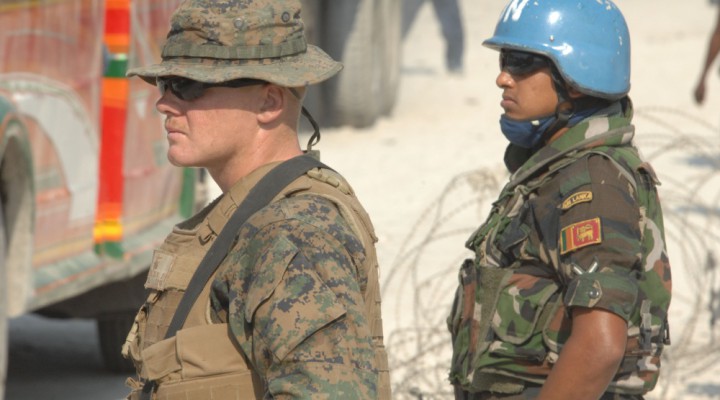U.S. “Peaceful” Interventions (II)

The more recent Strategy to Prevent Conflict and promote Stability (published in 2020) points to a change in the overall approach in the interventions the U.S. undertakes.
“Rather than externally driven nation-building, the United States will support locally driven political solutions that align with United States’ national security interests. Rather than fragmented and broad-based efforts, the United States will target the political factors that drive fragility. Rather than diffuse and open-ended efforts, the United States will engage selectively based on national interests, host-nation political progress, and defined metrics. Rather than implementing a disparate set of activities, the United States will strategically integrate its policy, diplomatic, and programmatic response”.
Indeed, the U.S. used to practice so-called “nation-building” – its own concept, imposed on other countries as the only correct recipe for the development of the state. Afghanistan is a perfect example of how correct and effective this model was. Of course, there the priority was given to all those liberal-democratic attitudes that exist in the U.S., without taking into account the cultural and religious specifics of the target country.
But in the new approach, again, the main interest is to ensure the security of the United States. Which factors will be chosen as contributing to instability depends entirely on the decision makers in Washington. There is no doubt that in Lebanon, for example, they will include the Hezbollah political party and their allies among such factors. But the Kurdish Self-Defense Forces in Syria, which Turkey considers a terrorist group and Syria itself, at least, an armed opposition, are unlikely to be on that list. Because these are forces that are used as proxies by the U.S. itself.
Let’s look at the goals specified in this strategy. The first, called “Prevention”, states that one of the objectives is to “develop and/or reinforce local, national, and regional early warning systems and early action plans, backed by preventative diplomacy”.
Let’s recall that preventative diplomacy is nothing more than a set of verbal threats to an actor. Although the UN website gives a milder formulation – “diplomatic actions aimed at preventing disagreements between parties, the escalation of existing disagreements into conflict, as well as to limit the spread of existing conflict”.
It can be misleading, as can the “Responsibility to Protect” doctrine, which, judging by the practice and reactions of a number of countries, is the exclusive prerogative of the West. Since none of the authors of this doctrine rushed to defend the Russian-speaking population in 2014 after the coup in Ukraine and the military repression that began in southeastern Ukraine, preventative diplomacy will also be directed against those countries and governments that are not clients and satellites of the United States.
Similarly, the second goal, titled “Stabilization”, reads: “Assist national and local actors, including, inter alia, civil society and women leaders, to broker and implement durable and inclusive peace agreements or ceasefires and related transitional justice and accountability provisions”.
The manipulation of NGOs and gender projects by the U.S. has long been known. And the authors here only emphasize these factors.
The strategy also notes the tools of sanctions, financial pressure, intelligence, monitoring and strategic communications.
Other documents are also mentioned in the stabilization guide. One of them is the U.S. Strategy on Women, Peace and Security (last version released in June 2019).
It can be used as an additional justification for intervention, as all four lines of effort can be interpreted as justifying interventions.
- Seek and support the preparation and meaningful participation of women around the world in decision-making processes related to conflict and crises;
- Promote the protection of women and girls’ human rights; access to humanitarian assistance; and safety from violence, abuse, and exploitation around the world;
- Adjust United States international programs to improve outcomes in equality for, and the empowerment of, women;
- Encourage partner governments to adopt policies, plans, and capacity to improve the meaningful participation of women in processes connected to peace and security and decision-making institutions.
Finally, the last key document mentioned is the Pentagon’s Irregular Warfare Directive No. 3000.07.
It states that IW-related activities will be integrated with the efforts of other U.S. Government (USG) agencies, foreign security partners, and selected international organizations by supporting:
- Combined policies, plans, and procedures, including collaborative training, education, and exercises that promote interoperability.
- Integrated civilian-military teams.
- Information strategies and operations to neutralize adversary propaganda and promote U.S. strategic interests.
- Efforts to enhance information sharing, as appropriate, to synchronize planning, execution, and transition of IW activities and maintain the shared understanding of the operational environment required to counter irregular challenges or threats.
- Integration of collective requirements and capabilities into unified planning efforts to optimize development and employment of capabilities.
- Provision of essential governmental services, emergency infrastructure restoration, and humanitarian relief, if directed.
As we can see, once again U.S. strategic interests are mentioned, but even the actions of special operations forces, whose prerogative is irregular warfare, indicate the clearly non-peaceful nature of the intentions themselves, not to mention the possible practical actions.
https://orientalreview.org/2023/01/12/u-s-peaceful-interventions-ii/
 TheAltWorld
TheAltWorld 
0 thoughts on “U.S. “Peaceful” Interventions (II)”